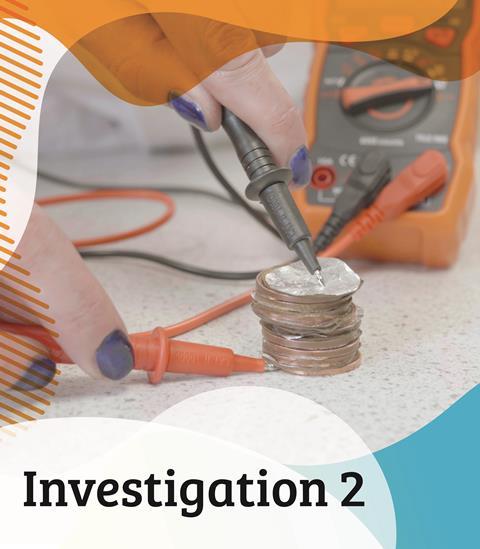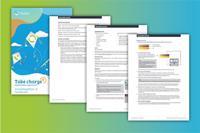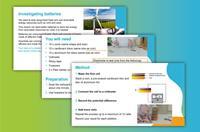Investigation 2
Here you will find all the support you need to join in with investigation 2
Teaching and learning resources
We have a full set of teaching notes to support you, along with learner instructions in PDF or as PowerPoint slides to be used in the classroom. Instructions for carrying out the investigation are included in both, and you can watch the video below before you start.
Use the battery power worksheet (also available in PDF) to find out more about battery research and development from the past to the present day.
Equipment
To take part in investigation 2, each group will need:
- 10 coins or washers (of the same size)
- aluminium foil
- cardboard
- voltmeter (or multimeter)
- 2 petri dishes (or similar)
- tweezers
- pencil
- sticky tape
Each group to test one electrolyte from the following list:
- deionised water (distilled water can also be used)
- saline solution; sodium chloride solution, 1.0 mol dm–3 (1 teaspoon salt in 100 cm3 water)
- sodium hydroxide solution, 0.1 mol dm–3
- sulfuric acid solution, 0.4 mol dm–3
- vinegar, 5%; equivalent to ethanoic (acetic) acid solution, 0.8 mol dm–3
Learning objectives
- Understand that batteries are made up of cells, comprised of layers of different materials.
- Understand that changing the different layers of a cell can affect its performance.
Enquiry skills
This investigation covers many different scientific enquiry skills. You may want to choose just one or two to focus on.
Scientific attitudes
- Pay attention to objectivity as well as accuracy, precision, repeatability and reproducibility.
Experimental skills and investigations
- Make and record measurements using a range of methods.
- Evaluate the reliability of the methods and suggest possible improvements.
Analysis and evaluation
- Present observations and data using appropriate methods including graphs.
- Interpret observations and data to draw conclusions.
- Identify further questions arising from results.
Record and submit your data
1. Record your results
You can use this worksheet for learners to record their results in the lesson (also available as a pdf).
2. Prepare your data
If you have multiple sets of data, you can download our results template (Excel spreadsheet) for this investigation. Simply follow the instructions included with the template, then go to step 3.
3. Share your data
When you’re ready, you can input your data directly or upload your completed results template.
FAQs
Here are some frequently asked questions about this investigation, along with answers for learners at this level. Don’t see your question here? Let us know and we will do our best to add it to the list.
1. Why does the sodium hydroxide produce a larger potential difference than the other materials?
Different solutions cause the chemical reactions to happen at different rates and can create a bigger ‘push’ of current around the circuit.
2. Why are there small holes in the aluminium foil after using the battery?
The aluminium reacts with the electrolyte leading to the aluminium foil being used up.
3. Why do more cells lead to a greater potential difference?
With more cells the ‘push’ of current round the circuit is greater.
4. Why are the cardboard discs dipped in a solution (the electrolyte)?
The particles in a solid cannot carry the flow of charge from one electrolyte to another.
5. Why does the battery run out?
Batteries ‘run out’ when one of the chemicals taking part in the reactions has fully reacted and is no longer available.
6. How do rechargeable batteries work?
A rechargeable battery works in the same way as a coin cell when being used (eg to light an LED). However, the chemicals inside are different. When they ‘run out’ they can be connected to a charger to reverse the chemical reactions and ‘recharge’ them.
7. Could we get a shock if we made a really high stack?
If you make a voltaic pile with more than 10 cells it is possible to get a small electric shock from it. This is how Alessandro Volta originally measured how powerful his batteries were by giving himself electric shocks.







